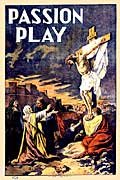 The Bible
The Bible (John Huston, 1966) has come to be known, somewhat unfairly, as the film that killed the biblical epic. It's a charge that somehow persists despite three major objections. Firstly, it hardly makes sense to blame a single film for destroying a genre, and even if did, that accusation should surely be pointed at
The Greatest Story Ever Told (1965) which blew £25 million for very little return, rather than at this. Secondly because rather than being an example of the worst of the genre it is surely one of it's best. Indeed, in concluding his masterful survey of the films of the Hebrew Bible, Jon Solomon cites it as one of the three "most representative and iconographical Old Testament depictions of the twentieth century" (175).
More significantly, of course is the fact that rumours of the genre's demise turn out to have been greatly exaggerated. Whilst
Jesus Christ, Superstar, released just seven short years later, is not exactly an epic, it would have seemed hard to argue in 1973, that the Hollywood Bible film was enjoying anything other than reasonable health.
Huston himself was one of the greatest figures in Hollywood. He burst onto the scene in 1941 with the brilliant PI flick
The Maltese Falcon before heading to the front line of World War II and creating a series of documentaries for the army.
Key Largo and
The Treasure of the Sierra Madre (both 1948) reunited him with Bogart, as did
The African Queen (1951) and the spoof,
Beat the Devil (1953) and his catalogue of famous films extended all the way beyond
Prizzi's Honor in 1985. In between times he found time to continue the Hollywood dynasty founded by his father Walter, with three of his five children (Anjelica, Tony and Danny) going on to have prominent roles in Hollywood, as well as his grandson Jack, who had the lead role in the 2016 version of
Ben-Hur.
Houston acted too., Most famously in Polanski's
Chinatown (1974), but also here as an amiable Noah. Both Alec Guinness and Charlie Chaplin had initially been considered for the role, but Huston brings a cheerful sense of purpose to the impending destruction of humankind. All this however is only after a masterful creation sequence and the sight of Michael Parks and Ulla Bergryd cavorting in the altogether behind a series of strategically-placed plants.
For the opening sequences, Huston narrates the opening chapter of Genesis over a series of stunning collection of images of the natural world: molten lava bubbles and flows as the land is separated from the sea; a gigantic sun rises, and moves across the skies, as the greater light is brought forth; and swarms of fish burst through the waters of the deep, as the creatures of the seas are created.
What is impressive about the creation sequence, in addition to the jaw dropping beauty of the images, is the way they so skilfully plot a course between a seven-day type literalist interpretation on the one hand, and more metaphorical readings on the other. Just like the written text, the viewer looks at the raw material and is able to apply their own interpretation. Furthermore, even after numerous nature documentaries and a number of cheap rip-offs the sequence still creates a sense of awe, even if Huston's use of the archaic King James Version and one of the more conventional parts of the soundtrack date things a little.
The soundtrack excels elsewhere however. Following the creation of Adam, and then Eve the fall and the scenes where Cain (Richard Harris) kills his brother are accompanied by more atonal music. This combined with the bizarre poses Harris strikes, and the low and then high camera angles make this whole sequence strange and disorientating. Whilst the narration is rigidly literal to the text, the film uses the more cinematic elements of image and sound to suggest this more mythical reading.
The one exception to this is Huston's Noah segment, which goes for more of a light-hearted family comedy feel. Gone is the slavish dependence (or at least the appearance of it) on the biblical text. Instead get other characters get to speak, such as Noah's wife who doesn't quite understand what is happening and Noah's disbelieving compatriots insulting him and calling him "stupid".Noah himself gets to use words and phrases not found in the text of Genesis such as when he suggests that the tigers are "only great cats" who can survive on milk from the other animals. Interspersed with this we get Huston mugging for the camera, visual jokes about the tortoises being last on to the arc and the slapstick spectacle of Noah sticking his foot in a bucket of pitch and sliding down the top deck. It's not that these homely touches are necessarily that bad, just that they feel somewhat out of place with the broody, otherworldly tone struck by the rest of the film. Huston rarely appeared in his own pictures, and perhaps this misstep gives a suggestion as to why. With that on top of having to manage an on-set zoo, it's hardly surprising he was repeatedly heard to quip "I don't know how God managed, I'm having a terrible time" (Huston 320).
In some ways, however, the film's episodic and inconsistent nature does mark it as a film of transition. Following the poor box office performance by both
The Bible and
The Greatest Story Ever Told, big studios seemed more reluctant to outlay immense budgets for biblical epics. Instead the 70s were featured the broadcast of numerous made-for-TV series marking the "migration of biblical narratives into the medium of television" (Meyer 232).
The rest of the film returns to this more pre-historic feel, aided by some fantastic high contrast lighting with gives so much of the film this eerie aura. Stephen Boyd's Nimrod, complete with a painted on mono-brow, shots his arrow to the sky and quickly finds there is no longer anyone who can understand his orders and then we swiftly move on to the sight of George C. Scott's Abraham leaving Ur.
Again the film does well presenting the main stories here (birth of Ishmael, visitation of the angels, the fall of Sodom and the aborted sacrifice of Isaac) in biblically faithful fashion whilst also questioning the legitimacy of that presentation. Particularly strange is the sight of Abraham's three ethereal visitors interchangeably using Peter O'Toole's head and an orgy scene dreamed up for Sodom that is more creepy than it is titillating.
The way these scenes pan out leaves Abraham's story, which comprises almost the film's entire second act, as some sort of hope for humanity, even as it hints of the rocky, even traumatic road ahead. The jump from a scene of he and Isaac walking stealthily through the chillingly charred remains of Sodom, to preparing for Abraham to kill his child, provokes anger rather than reverence. Abraham is troubled, but also haunted by the temperamental God who commands him. His willingness to sacrifice his son is more an act of fear of what might happen if he refuses than one of faithful service.
It's a fitting end to what is - in contrast to the majority of epics that went before it - "a personal film on a gigantic scale (Forshey 146). In some ways that is far more reflective of Genesis itself. Whilst chapter one paints of a broad scale, from there on in it's the story of God with a string of individuals - Adam, Cain, Noah, Abraham, Isaac, Jacob and Joseph. Huston's film not only gets this, but its highly literal narration, in tandem with its dark and primitive feel, underlines the mythological nature of the texts giving much of the film a strange sense of the dawn of time, and the primitive nature of the cultures involved. Whilst the change of tone in the Noah section is a little misplaced, it's hard to deny to boldness of Huston's artistic vision.
================
- Forshey, Gerald E. (1992) American Religious and Biblical Spectaculars Westport CT: Praeger.
- Huston, John (1981)
An Open Book. London: Macmillian.
- Meyer, Stephen C. (2015)
Epic Sound: Music in Postwar Hollywood Biblical Films, Indianapolis: Indiana University Press.
- Solomon, Jon. (2001)
The Ancient World in the Cinema, (Revised and expanded edition). New Haven: Yale University Press.
Labels: Abraham, Bible (The - Huston), Cain and Abel, Genesis, Lot/Sodom & Gomorrah, Noah






























